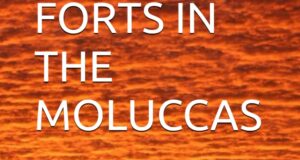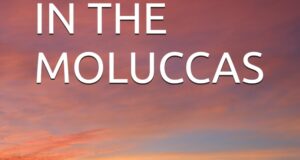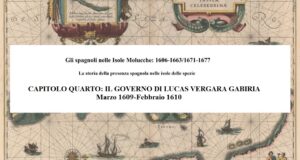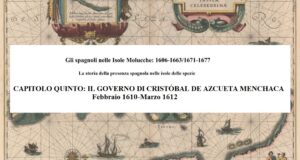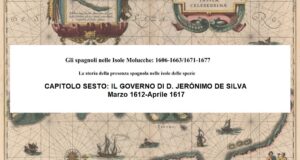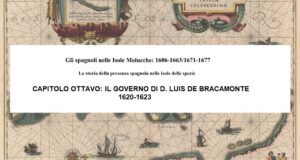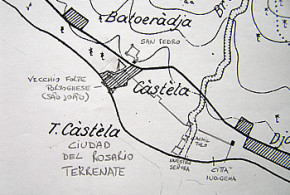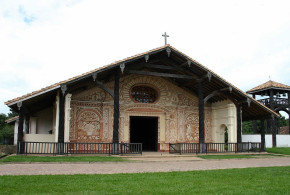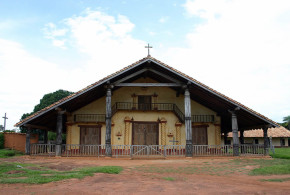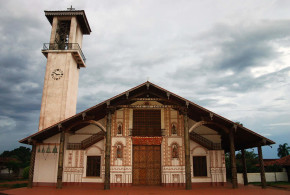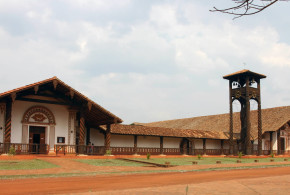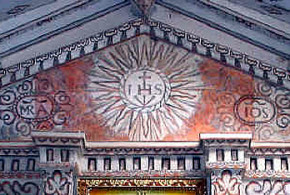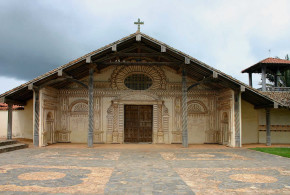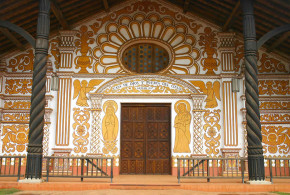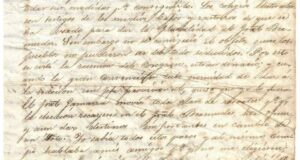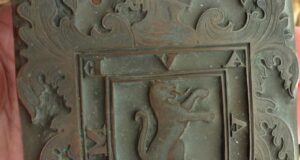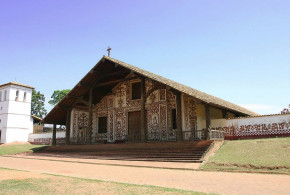This post is also available in:
![]() Italiano
Italiano
The Spaniards in the Moluccas: 1606-1663/1671-1677. The history of the Spanish presence in the spice islands
Written by Marco Ramerini. 2005-2020/23
INTRODUCTION
In the early 2000s I had started researching the Spanish presence in the Spice Islands. Some of my research was published during those years. The largest, however, remained unfinished in the files on my computer. Now after 15 years I’ve taken it back and I’m starting to publish it on my website www.colonialvoyage.com.
This study consists of 11 chapters in addition to the bibliography and was originally published in Italian (in October 2020) on my site dedicated to the history of geographical explorations and colonialism: www.colonialvoyage.com
The translation is done by me, and it’s certainly not professional, but that’s all I could do.
This study consists of 11 chapters:
INDEX
1: The first contacts of the Spaniards with the Moluccas
2: The conquest of Ternate
3: The government of Juan de Esquivel, May 1606-March 1609
4: The government of Lucas de Vergara Gabiria (acting the functions), March 1609-February 1610
5: The government of Cristóbal de Azcueta Menchaca (who performs the duties), February 1610-March 1612
6: The government of D. Jerónimo de Silva, March 1612-April 1617
7: The government of Lucas de Vergara (Bergara) Gabiria (second term), April 1617-February 1620
8: The government of D. Luis de Bracamonte (who performs the functions), February 1620-1623
9: The government of Pedro de Heredia, 1623-1636
10: The government of D. Pedro Muñoz de Carmona y Mendiola (who performs the functions), March (?) 1636-January 1640
11: The last Spanish governors of the Moluccas
12: Bibliography
CHAPTER ONE: THE FIRST CONTACTS OF THE SPANIARDS WITH THE MOLUCCAS ISLANDS
CLOVES
The islands formerly known as Moluccas or Spice Islands were five islands of volcanic origin (Ternate, Tidore, Moti, Makian and Bacan) located west of the coast of the island of Halmahera, in the Indonesian archipelago.
These islands were the only ones in the world where, at the time of the Portuguese arrival, the clove plant grew naturally, a plant of the Myrtaceae family, whose botanical name is Caryophyllus Aromaticus (Eugenia Caryophyllus, Syzygium Aromaticum). This plant is a tree that reaches an average height of 10-15 meters. The unopened and dried flower buds of this plant are called cloves.
The clove plant produces fruit from the fifth to sixth year of growth and can live well beyond 70 years. On average, a tree annually produces 3 kg of dried flowers equal to 6 kg of fresh flowers, in particularly productive years, which is repeated on average every 4 years, a plant can produce up to over 30 kg of cloves. In the Moluccas the flowering season falls twice a year in the months of September and December. To thrive, the plant needs a humid climate, but also a well-drained soil, conditions that are found in the Moluccas islands. The plants grow along the slopes of the mountains, at mid-height.
This peculiarity made the Moluccas famous and mythical since ancient times. The clove was a very important commercial product, in the past it was traded both in Asian markets (China, India and Arab countries) and in European ones; it was used in the form of oil for the treatment of food, as a perfume, as an essence to perfume the breath, as an anesthetic for toothaches and as an ingredient for various types of food (in medieval English cookbooks about 20% of recipes contained cloves as an ingredient).
The Moluccas had this great wealth, the clove, but they had to import from the other islands, the basic necessities such as mainly sago and rice which were imported from Halmahera, Ambon and Bacan; spices were instead exchanged with traders from all over Asia for clothes, silk, porcelain, gold, silver, knives, glass, etc. 1
VOLCANIC ISLANDS
Most of the islands of the Moluccas archipelago are dominated by high volcanoes, some of which are still active. On the island of Ternate there is the Gamalama volcano which is 1,715 meters high. This volcano from 1538 to today has had over 70 known eruptions. In the period 1538-1700 it had eruptions in: 1538, 1561, 1605, 1608, 1635, 1618 (?), 1643 (?), 1648, 1653, 1659, 1676, 1686, 1687). The neighboring island of Tidore is also dominated by an impressive volcano, Kiematubu, a stratovolcano with a height of 1,730 meters. This volcano has not had any documented historical eruptions, but it did erupt in the Holocene. Another active volcano is instead present in the island of Makian, 1,357 meters high, it is a destructive volcano. In the period 1550-1700 it had eruptions in 1550 and in 1646 when it had an explosive eruption which devastated several villages on the sides of the volcano.
In addition to the 5 main islands (Ternate, Tidore, Moti, Makian and Bacan) there are the three small volcanic islands of Hiri (630 m., which had eruptions in the Holocene) located north of Ternate. Maitara (357 m.) in the arm of the sea that separates Ternate and Tidore. While to the south, between Tidore and Moti, is the island of Mare (308 m., with eruptions in the Holocene).
Of all the Moluccas, Makian Island was the one that produced far more cloves than any other in the seventeenth century. The cause of this greater production Governor D. Gerónimo de Silva attributes it to the better propensity of the inhabitants of Makian in the cultivation of the land, unlike the natives of Ternate and Tidore who were more inclined to make war than to cultivate the fields.2 Makian was also the most densely populated. 3
Due to the continuous commercial contacts between the Moluccas and Muslim merchants from Arabia and other parts of Asia, the Mohammedan faith entered the islands from 1430-1460. In those years several kings of the islands converted to Islam and at the arrival of the Portuguese despite the fact that the majority of the population was still animist, Islam represented an important and elitist element in the islands. 4
THE SITUATION ON THE ARRIVAL OF THE PORTUGUESE
Upon the arrival of the Portuguese in 1512, two main kingdoms vied for control of the islands: the Sultanate of Ternate and the kingdom of Tidore. In addition to the island of Ternate, the Sultanate of Ternate also controlled half of the island of Moti, the northern part of the island of Halmahera called Moro, the island of Ambon, the eastern part of Ceram and the northeastern area of Sulawesi. As the Kingdom of Tidore, it controlled besides Tidore Island the other half of Moti Island, Makian Island, most of Halmahera Island and the western part of New Guinea. Control over these islands was exercised directly or through vassalage.
Then there were two other minor kingdoms: that of Bacan and that of Jailolo. The kingdom of Bacan, whose capital was on the island of Kasiruta, extended its influence over the archipelago of Bacan and the northern part of Ceram. Bacan was a major producer of sago, the staple food of the island peoples, but it was sparsely populated. The kingdom of Jailolo instead had once been the most important of the region but in 1500 it was in decline and controlled only the northwestern part of Halmahera, this kingdom will be practically annexed by Ternate and the Portuguese in 1551.
The sultan of Ternate managed to secure the Portuguese alliance and in 1522 asked and obtained the construction of a Portuguese fortress on his island. The first stone of the fortress was laid for the feast of St. John the Baptist, on June 24, 1522, and for this reason it was called “São João Baptista de Ternate”. The alliance with the Portuguese unbalanced even more in favor of Ternate the power relations with Tidore, on the other hand Tidore at the arrival of the ships of the Magellan expedition promptly requested the assistance of the Spaniards. 5
The Spaniards first made contact with the Maluku Islands during Magellan’s expedition. In 1521 the ships of Magellan’s expedition reached the Moluccas, where they stayed for about six weeks on the island of Tidore. They also founded a farm, which however was promptly destroyed by the Portuguese.
The Spaniards tried several times to take possession of the spice islands to the detriment of the Portuguese, with whom there were bitter differences, the Spanish established alliances with the kings of Tidore and Jailolo and Spanish troops were present in the islands during the years 1527-1534 and 1544-1545. But the failure to discover a return route across the Pacific prevented the Spanish from being able to compete with Portuguese naval power. In 1529 there was also the signing of a treaty between Spain and Portugal, concerning the Moluccas, the Treaty of Zaragoza, with this treaty the king of Spain abandoned any claim on the islands in exchange for 350,000 ducats.
The first period of interest of the Spanish in the Moluccas was characterized by the struggles against the Portuguese for control of the islands, it began with the arrival of Magellan’s expedition in 1521 and ended in 1545 with the surrender of the men of the army to the Portuguese of Villalobos, between these two expeditions the Spaniards sent other fleets, those of Loaisa (1527) and Saavedra (1528) as well as the unfortunate adventure of the Grijalva expedition (1538). The Villalobos expedition was set up after the Treaty of Zaragoza and for this reason the expedition was directed to unspecified spice islands not yet occupied by Portugal. The center of all this Spanish activity remained throughout this period the island of Tidore.
THE EXPEDITION OF MAGELLAN
The Spaniards had the first contacts with the island of Tidore, during the expedition of Magellan. In 1521 the two surviving ships of the expedition, the ‘Trinidad’ and the ‘Victoria’, arrived in the Moluccas Islands. The Spanish vessels entered the port of Tidore on November 8, 1521, where they were well received by the king of the island. The vessel ‘Victoria’ remained at Tidore until 21 December 1521, whence she departed on the Indian Ocean route to Europe, which she successfully reached on 6 September 1522. The ‘Trinidad’ however, which needed to be repaired, sailed from Tidore on April 6, 1522 trying without success to cross the Pacific Ocean, she was forced to return to the Moluccas in October 1522, where the crew was captured by the Portuguese, who in the meantime had settled in Ternate where they had built a fortress. 6
The first contact with the Tidorese was purely commercial, even if the Spanish, following the request of the king of Gilolo, an ally of Tidore, supplied two pieces of artillery and some soldiers to participate in a punitive expedition against an enemy of the king. The kings of Gilolo and that of Tidore declared themselves subjects of the king of Spain, hoping in doing so to balance the overwhelming power of their bitter enemy, the sultan of Ternate, with Spanish help. This act of submission greatly angered the Portuguese, who had already had commercial relations with Ternate for some years and who considered the entire Moluccas archipelago as their own possession.
The Spaniards, upon their departure, promised the king of Tidore that with the subsequent expedition they would build a fortress in Tidore, and for this purpose, they left on their farm in addition to the merchandise and 5 men 7 also 40 ‘bombardadas’, many ‘beftas’ and ‘espigardas’ and several other weapons. 8
THE LOAISA EXPEDITION
The promise of building a fort at Tidore was, in fact, fulfilled. In fact, the next expedition, under the command of which was originally Loaisa, built a fortress of stone, sand and crushed stone at Tidore. The small fort was built in January 1527 in the main city of the island.
Let’s look in more detail at the events that led to the construction of the first Spanish fort at Tidore. After crossing the Pacific Ocean, the only surviving vessel of the Loaisa expedition, the ship ‘Victoria’, commanded by Captain Martin Iniguez de Carquizano, arrived within sight of the Moluccas and stopped for a few days at Zamafo a village controlled by Tidore in the island of Halmahera. Following the request of the king of Tidore, the Spaniards moved to Tidore, which they sighted on December 31, 1526 at the first light of dawn, they then took the boat to the north-eastern part of the island of Tidore where they spent the night. 9
The following morning, January 1, 1527, the Spaniards headed to the place where the main city of the island was, called ‘Tidori’. The city was located in the eastern part of the island‘…el pueblo principal que se llama Tidori està por la parte de leste…’ 10, it had been completely destroyed and burned by the Portuguese in late 1526 during the previous war. 11 Here the Spaniards arrived at 10 in the morning and immediately met the young king of Tidore (Raja-Mirr) on board the ship, he confirmed his loyalty to the king of Spain and asked for the help of the Spaniards to counter the Portuguese and their allies from Ternate. The Spaniards helped by the Tidorese, on the very day of their arrival, began the construction of three bulwarks‘…en este mismo dia comenzamos hacer tres baluartes en tierra para poner artilleria…’ 12 of stone, earth and wood in order to be able to defend itself against a certain imminent attack by the Portuguese.
The sources do not agree on what the fortifications built by the Spaniards must have been like. According to the testimonies, the construction of a bulwark entirely of stone is reported ‘…fizemos un baluarte a maneira de fortaleza de pedra soomente…’ where the artillery was placed, while on a point the Spaniards had placed two large artillery pieces. 13 Other sources speak of two bulwarks ‘onde chegado & metida a nao dentro no arrecife, mandou fazer naentrada dele dous baluartes de pedra ensosa q artilhou muyto bé com algúa artelharia da nao’ 14 and more ‘…e fez de pedra sequa dous baluartes sobre o arrecife em defensão da nao, e n’elles pôs artelharia, …’ 15
Still others talk about ‘…torre dos castelhanos, a que elles chamauão fortaleza, que tinha huma caua d’agoa derrador; …’. 16 ‘…torre dos Castelhanos, a que chamauão fortaleza, que como disse era cercada de caua’. 17 Diogo do Couto tells us that the Spaniards began to build with great speed two ‘baluartes de pedra ençossa’ at the limits of the city, while another bastion was built to defend the port. 18 Other testimonies inform us that the bulwark was not only made of stone, but also of earth and wood ‘…y luego en la hora hecimos en tierra un reparo de piedra, y tierra, y madera para poner alguna artilleria para nos defender…’ 19 ‘se fortificó com fortes tramqueiras y artilleria con nombre de fortaleza’. 20
From the descriptions it is clear in any case that the fortifications that the Spaniards built at the time of the landing in Tidore were two bulwarks, one probably the main one, the one that was called a fortress, was built inside the city of the King near the sea, the other in its vicinity, on a point. Furthermore, later, in June 1528, Hernando de la Torre probably had another defensive bulwark built on the north side of the city. What is certain of this first Spanish fortification in Tidore is that it must have been a work of little importance, given the haste with which it was built. The small fortification was also used as a shelter for goods transported by ships ‘… e ally desembarcaron el artillería, y sus mercaderías y comenzaron á hacer un baluarte para su defensa: y metiéronse en él con todas sus mercaderías y artillería, …’. 21
The day following the arrival of the Spaniards, the artillery and goods that were on board the ship were landed. About half of the ship’s occupants went ashore, while the other half remained aboard because the Spanish feared that the Portuguese would try to scuttle the ship. There were just over 100 22 Spaniards who arrived in Tidore, and the ship ‘Victoria’ represented the only means at their disposal to attempt to return to Spain.
The Spaniards almost immediately had to repel an attack by the Portuguese, who also attacked Tidore several times in the following months. The Portuguese tried by all means to harm the Spanish, the Spanish captain Martin Iñiguez de Carquizano was poisoned by them and died on July 11, 1627 23, he was succeeded as leader of the Spaniards by Hernando de la Torre. The Spanish actively took part in the struggles between them, Tidore and Jailolo on one side and Ternate and the Portuguese on the other.
Meanwhile in New Spain a new expedition was being prepared for the Moluccas, this fleet, made up of three ships (‘Florida’, ‘Santiago’ and ‘Espiritu Santo’) with 30 cannons and 110 men, had left on 31 October 1527 from Mexican port of Zihuatanejo, the commander of the expedition was Alvaro de Saavedra Ceron. Of this expedition only the ship ‘Florida’ commanded by Alvaro de Saavedra Ceron arrived in Tidore on March 30, 1528, on board were 45 men who replenished the ranks of the scarce Spanish troops present in Tidore and Jailolo and strengthened the morale of the Spaniards. 24 But the failure to discover a return route across the Pacific despite many desperate attempts prevented the Spanish from receiving further aid and communicating with their bases, while on the other hand the Portuguese constantly received reinforcements from Malacca and Goa.
Upon the arrival of the new Spanish ship at Tidore, the fortress of the Castilians appeared as a fortress of stone, sand and rubble (‘piedra, arena y cascajo’) two arms high and six feet thick, it was armed with a cannon, a ‘culebrina’, two ‘sacres’ and many other pieces of iron artillery, a good quantity of ‘escopetas’ and ‘ballestas’, it appeared to be quite well stocked with artillery and the troops were well armed. 25
In addition, other defensive works were prepared by the Spaniards: In a report to the king of Spain written by Tidore on June 11, 1528, Hernando de la Torre, indicated that in order to better defend the city it was necessary to build a bulwark at an entrance to the city of Tidore for the purpose, he had placed 20 soldiers led by Diego de Ayala at that point and with 5 or 6 pieces of artillery. 26
Despite the construction of these successive defense works, the Spanish fort was taken by the Portuguese in October 1529. The Portuguese could not have chosen a better moment for the attack, in fact, the Spanish had divided their forces by sending 18 soldiers along with the troops of Tidore for a punitive expedition in the northern part of Halmahera. A small garrison of 37 Spaniards remained in defense of the city of Tidore of which only 25 were able to take up arms, the number of Tidore troops remaining in defense of the city was also reduced.
The city of Tidore was attacked on 28 October 1529 by the Portuguese and their Ternate allies, here the Spanish initially attempted resistance along the city wall and along the bulwark that had been built at the entrance to the city, but then saw the superior number of the Portuguese and their allies, were forced to retreat within the walls of their fortress. The Portuguese burned the whole city of Tidore and laid siege to the Spanish fortress. The Portuguese asked for the surrender, under penalty of killing all the defenders of the fortress.
The Spaniards commanded by Hernando de la Torre after several discussions agreed to abandon the fortress on the condition of being transferred to the village of Zamafo on the island of Halmahera. The Portuguese also imposed a ban on them returning to the Moluccas ‘…no fuese en ninguna de las cinco islas de clavo’. Captain Hernando de la Torre left Tidore for Zamafo together with 23 Spanish soldiers, while another 12 remained with the Portuguese and entered their service. 27 In the fortress and in the farm that was inside the Spanish fortress, the Portuguese, in addition to various merchandise, confiscated many weapons including 6 large metal artillery pieces, 25 iron artillery pieces (‘…versos y falcones…’) , 4 large pieces, 4 ‘pasamuros’, 8 ‘falcones’ e altri ‘tiros pequeños’. 28
After the Portuguese conquest of the Spanish fort of Tidore, it seems that some Portuguese soldiers remained to garrison the island ‘… habia quedado gente de portugueses en Tidori…’ 29 Castanheda also mentions that some Portuguese remained in Tidore to teach the Tidorese ‘os nossos costumes’ and to prevent an alliance between Tidorese and Spaniards from happening again in the future. 30
As we have seen this first fortress built by the Spanish at Tidore was a very simple construction of dry stone wall, probably just a small defensive bastion: ‘Los portugueses nos echaron por armas de Tidori, donde teniamos una fortaleza de piedra seca y toda l’artillería y hacienda que teniamos para nuestro mantenimientos, y dos fustas…’ 31 ‘…la fortaleza que tenian hecha los castellanos á manera de baluarte’ 32 The Spanish held the fort of Tidore for almost three years from 1 January 1527 to 28 October 1529. The few Spaniards who remained with Hernando de la Torre remained for a few more years in Jailolo, from where they were then embarked between 1534 and 1535 towards the ‘India and then to Spain. 33
The survivors of the Grijalva expedition arrived in the Moluccas a few years later, in 1537, but they immediately surrendered to the Portuguese and had no influence on power relations in the Moluccas. 34
THE VILLALOBOS EXPEDITION
The last Spanish contact with the Spice Islands before the union with Portugal was with the expedition led by Ruy López de Villalobos. The destination of the expedition, by virtue of the 1529 agreement, was the unspecified spice islands not yet occupied by the Portuguese. Villalobos left Mexico on November 1, 1542 with 4 ships, a galliot and a brig. After a failed attempt to colonize the island of Sarragan, the remnants of the expedition reached Gilolo where they were well received by the king, who offered them permission to build a fortress. Later the king of Tidore also went to Gilolo 35 where he visited the Spanish and a contract of alliance was again made between Spain, Tidore and Gilolo. A group of 60 Spanish soldiers commanded by don Alonso Manrique was sent to Tidore. Later the other Spanish troops also moved to the island. 36
The Spaniards of Villalobos helped their allies against their enemies in several battles, but always avoided fighting against the Portuguese, maintaining friendly relations with them, and exchanging visits, which made the king of Tidore suspicious, who in August 1545, to defend himself and protect himself, he had a dry stone fortress built on top of a hill ‘… hizo fortalezer un peñol y ençima del hizo una fortaleza de piedra seca, para se recojer alli si neçessario fuese, …’. 37
The Spanish repeatedly tried to establish contacts with New Spain, but all the ships sent were forced to return to the Moluccas without having found a return route to America, this caused deep discouragement in the Spanish, who began to desert and go over to the side of the Portuguese, the Spanish were forced to negotiate a surrender with the Portuguese and abandon Tidore, they had been in Tidore from March 1544 to November 1545. 38
In February 1546 the survivors of the Villalobos expedition left the Moluccas aboard Portuguese ships. Villalobos will die in Ambon on his return journey to Spain. 39
THE SPANISH EXPEDITIONS DURING THE UNION OF THE CROWNS OF SPAIN AND PORTUGAL
The first period of interest of the Spaniards in the Moluccas, i.e. the one concerning the years 1521-1606, can be divided into two distinct parts: the first part was that, to which we have already mentioned, of the struggles against the Portuguese for control of the islands , it began with the arrival of Magellan’s expedition in 1521 and ended in 1545 with the surrender of the men of the Villalobos expedition to the Portuguese.
The second part of this first period, was instead that of the union between the crowns of Spain and Portugal, during this time the Spanish expeditions departing from the base of Manila in the Philippines, were sent with the aim of helping the Portuguese troops against the enemies Ternatese, who had rebelled against the Portuguese and who had expelled them from the island of Ternate in 1575. 40
The main aim of these last expeditions was the reconquest of the Portuguese fortress of Ternate. None of the six subsequent expeditions attempted by the Spaniards achieved their intended purpose. They began in 1582 with that of Francisco Dueñas, this first expedition had a purely informative nature on the military situation of the islands, Francisco Dueñas remained in the Moluccas for about two months between March and April 1582. The next expedition was the one commanded by D. Juan Ronquillo it took place between 1582 and 1583, the Spaniards collaborated with the Portuguese by helping them in some punitive expeditions against the nearby islands.
In 1584 it was the turn of Pedro Sarmiento and then in 1585 of Juan de Morón also these two expeditions did not have the desired success, the fortress of Ternate was attacked, but without result. A larger and better assembled armada set out for the Moluccas in 1593 under the command of Philippine governor Gómez Pérez Dasmariñas himself, but a rebellion and assassination of the governor himself before reaching the Moluccas led to the cancellation of the whole operation. The last Spanish expedition of this period was the one sent from Manila to rescue the Portuguese admiral André Furtado de Mendonça’s fleet, it was captained by Juan Juárez Gallinato, and departed from Manila in late 1602, a joint Spanish-Portuguese assault on the fortress of Ternate was unsuccessful.
Instead, the two attacks a few months apart, in 1605, by the sworn enemies of the Spaniards, the Dutch, led to the last forts still in Portuguese hands in the Moluccas: Ambon and Tidore.
Ambon fell without a fight on February 23, 1605, apparently due to the cowardly conduct of the fortress captain Gaspar de Melo and the personal interest of some Portuguese casados, who aimed at safeguarding their possessions. The Dutch rebuilt the Portuguese fort and left 130 soldiers as a garrison. The Dutch ships then set course for Tidore.
The Portuguese from the fortress of Tidore, commanded by Pedro Álvares de Abreu, did not surrender at the sight of the ships, but forced the Dutch to fight, but as we will see later, despite their courage, the fort was taken by the Dutch. The key episode was the explosion of the powder magazine of the fort, which caused the death of many defenders and a huge gash in the walls. 41 Tidore was captured by the Dutch on May 19, 1605. The Dutch, not having enough men to garrison a fortress, left Tidore with only a few men on a farm. Once in the Moluccas, the Dutch allied themselves with the greatest power in the area, the Ternate sultanate.
The extension of the territory controlled by the Ternate sultanate after the rebellion against the Portuguese and the capture of the Portuguese fort of Ternate (December 26, 1575), is described to us in an interesting document most likely written by Pedro Sarmiento in 1584 and entitled “Relación de the force, power and artillery held by the King of Terrenate”.
The dominion of Ternate extended not only on the island of Ternate but also to the strongholds of Jilolo, Çabubo (Sabugo), Ganconora (Gamkonora), Loloda all located along the western coast of the island of Halmahera, where there were other tributary villages of Ternate. At the north end of the island of Halmahera, the islands of Doi and of Morata (Morotai) were also tributaries as were many villages on the north coast of Halmahera, which years earlier had been Christianized by the Portuguese. South of Ternate they were under the control of the Ternatese Motel (Moti), Maquian, Cawa (Kayoa), Caxossa (?) etc. the influence of Ternate extended southwards to the surrounding islands Ambon and Buru, while towards the west the influence of Ternate reached the coasts of the island of Celebes. 42
INDEX
1: The first contacts of the Spaniards with the Moluccas
2: The conquest of Ternate
3: The government of Juan de Esquivel, May 1606-March 1609
4: The government of Lucas de Vergara Gabiria (acting the functions), March 1609-February 1610
5: The government of Cristóbal de Azcueta Menchaca (who performs the duties), February 1610-March 1612
6: The government of D. Jerónimo de Silva, March 1612-April 1617
7: The government of Lucas de Vergara (Bergara) Gabiria (second term), April 1617-February 1620
8: The government of D. Luis de Bracamonte (who performs the functions), February 1620-1623
9: The government of Pedro de Heredia, 1623-1636
10: The government of D. Pedro Muñoz de Carmona y Mendiola (who performs the functions), March (?) 1636-January 1640
11: The last Spanish governors of the Moluccas
12: Bibliography
NOTES:
1 (De Silva De Silva, C. R. “The Portuguese and the trade in cloves in Asia during the sixteenth century” In: An expanding world vol. 11, pp. 259-260) (“Letter by Acuña to Felipe III, Manila 1 July 1605” In: Blair, E. H. and Robertson, J. A. “The Philippine Islands, 1493-1898” vol. 14, pp. 58-59 nota n°5. Grande Dizionario Enciclopedico UTET, 1967, vol. 4, p. 625) (Doc. Mal. I p. 5*) (Trinidade “Conquista espiritual do Oriente” vol. I p. 45)
2 (“Letter by D. Gerónimo de Silva to the king Felipe III, Ternate, 13 april 1612” In: Correspondencia p. 7)
3 The island of Tidore is described by Prado as densely populated. (Prado p. 23)
4 (Doc. Mal. I p. 6*) (Trinidade “Conquista espiritual do Oriente” vol. I p. 45)
5 (Doc. Mal I pp. 3*-4*)(De Silva, C. R. “The Portuguese and the trade in cloves in Asia during the sixteenth century” In: An expanding world vol. 11, p. 261)
6 The Portuguese fort was founded by Antonio de Brito in June 1522, the first stone of the fortress was laid for the feast of St. John the Baptist, June 24, 1522, the fortress was called “Sao Joao Bautista de Ternate”. The fortress was built by the Portuguese, where was the main city of the Ternate sultanate (south of the island), one league from the main port of the island, called Talangame, where the ships were anchored.
7 They were: Juan de Campos de Escribano, Luis del Molino, Alonso de Cota Ginoves, Diego Arias and Maestre Pedro Lombardero. See: (Fernanadez de Navarrete “Colección de los viajes, vol. 4” p. 98) and also (“Declaraciones que dieron en Valladolid Gonzalo Gomez de Espinosa, Ginés de Mafra, y Leon Pancaldo, sobro los acontecimientos de la nao Trinidad en las Malucas” Documento n°40 in: Fernanadez de Navarrete “Colección de los viajes, vol. 4” (Madrid, 1837) p. 381). According to Castanheda the men who remained in Tidore were 10-12 men see: (Lopes de Castanheda “História do descobrimento e conquista da Índia pelos portugueses” Livro VI, cap. 5, p. 160) While according to Antonio Galvao there were 4 men see: (Galvao “História das Molucas” p. 205)
8 (Lopes de Castanheda “História do descobrimento e conquista da Índia pelos portugueses” Livro VI, cap. 10, 169; Fernanadez de Navarrete “Colección de los viajes, vol. 4” p. 98)
9 (“Derrotero del viage y navegacion de la armada de Loaisa…” Document n° 14 in: Fernanadez de Navarrete “Colección de los viajes, vol. 5” p. 285)
10 (“Derrotero del viage y navegacion de la armada de Loaisa…” Document n°14 in: Martin Fernanadez deNavarrete “Colección de los viajes y descubrimientos que hicieron por mar los españoles, vol. 5” (Madrid, 1837) p. 286)
11According to a Portuguese slave who had fled to Zamafo, the destruction had taken place a few days before the arrival of the Spanish ships. For this episode see: (Castanheda “História do descobrimento e conquista da Índia pelos portugueses” Livro VII, cap. 39, p. 438)
12 (“Relacion escrita y presentada al el Emperador por Andres de Urdaneta …” Document n°26 in: Fernanadez de Navarrete “Colección de los viajes, vol. 5” p. 412)
13(“Carta de Pedro de Montemayor escrita desde Cochin al Rey de Re del Portugal…, Cochin 14 Janeiro 1533” Document n°19 in: Fernanadez de Navarrete “Colección de los viajes, vol. 5” p. 343)
14 (Lopes de Castanheda “História do descobrimento e conquista da Índia pelos portugueses” Livro VII, cap. 42, p. 441)
15(Gaspar Correa “Lendas da India” vol. III, p. 175)
16(Gaspar Correa “Lendas da India” vol. III, p. 360)
17 (Lopes de Castanheda “História do descobrimento e conquista da Índia pelos portugueses” Livro VIII, cap. 6, p 569)
18(Diogo do Couto “Da Asia” Decada IV, parte 1, p. 190)
19 (“Derrotero del viage y navegacion de la armada de Loaisa…” Document n°14 in: Fernanadez de Navarrete “Colección de los viajes, vol. 5” p. 286)
20(“Al Rey de Portugal, Alfonso Mexia, Cochin 30 diciembre 1528” Document n°13 in: Fernanadez de Navarrete “Colección de los viajes, vol. 5” p. 240)
21(“Declaracion de Juan de Mazuecos” Document n°21 in: Fernanadez de Navarrete “Colección de los viajes, vol. 5” p. 363)
22 They were 105, 115, 116, 117 (Galvao “Historia das Molucas” p. 215), 123, 133 depending on the testimonies.
23 He was buried in the church of ‘Nossa Senhora do Rozairo’ evidently the name of the chapel erected by the Spaniards in Tidore. (“Carta de Pedro de Montemayor escrita desde Cochin al Rey de Re del Portugal…, Cochin 14 Janeiro 1533” Document n°19 in: Fernanadez de Navarrete “Colección de los viajes, vol. 5” p. 345)
24(Fernanadez de Navarrete “Colección de los viajes, vol. 5” pp. 94-113)
25(“Relacion que presentó en Madrid el Año 1534 Vicente de Nápoles sobre los sucesos de la armada de Saavedra …” Document n°37 in: Fernanadez de Navarrete “Colección de los viajes, vol. 5” 486) (Fernanadez de Navarrete “Colección de los viajes, vol. 5” p. 113)
26 (“Derrotero del viage y navegacion de la armada de Loaisa…” Document n°14 in: Fernanadez de Navarrete “Colección de los viajes, vol. 5” p. 308)
27(“Relacion de Hernando de la Torre de lo ocurrido en las Molucas contra los portugueses de la isla de Terrenate, desde su ingreso en aquellas islas hasta fin del año 1533” Document n°20 in: Fernanadez de Navarrete “Colección de los viajes, vol. 5” pp. 353-360) (Gaspar Correia “Lendas da India” vol. III, p. 359)
28 (“Declaracion de Francisco de Paris, marinero de la nao Victoria …, 25 otubre 1536” Document n°23 in: Fernanadez de Navarrete “Colección de los viajes, vol. 5” p. 375.) (Fernanadez de Navarrete “Colección de los viajes, vol. 5” p. 133)
29(Fernanadez de Navarrete “Colección de los viajes, vol. 5” p. 356)
30 (Lopes de Castanheda “História do descobrimento e conquista da Índia pelos portugueses” Livro VIII, cap. 7, p. 571)
31(“Carta de Hernando de la Torre a D. Alvaro de Zuñiga, Gilolo, marzo 1532” Documento n°18 in: Fernanadez de Navarrete “Colección de los viajes, vol. 5” p. 337)
32 “Declaracion de Juan de Mazuecos” Documento n°21 in: Fernanadez de Navarrete “Colección de los viajes, vol. 5” 364
33(Fernanadez de Navarrete “Colección de los viajes, vol. 5” pp. 150-155)
34 On the vicissitudes of this expedition see: (Galvão “História das Molucas” pp. 307-317)
35 According to Couto, it was the Spaniards who asked the king of Tidore for permission to move to Tidore. (Diogo do Couto “Da Asia” Decada V, parte 2, pp. 406-407)
36 (P. Pablo Pastells “Historia general de las islas Filipinas, 1493-1572” vol. I, clxxi In: D. Pedro Torres y Lanzas “Catalogo de los documentos relativos a las islas Filipinas existentes en el archivo de Indias de Sevilla. Procedido de una História General de Filipinas, por el P. Pablo Pastells, S. J.” (Barcellona, 1925-1936)
37 (“Relacion de Garcia de Escalante Alvarado” AGI: Patronato,23,R.10 in: Consuelo Varela “El viaje de don Ruy López de Villalobos a las islas del Poniente, 1542-1548” (Milano, 1983) pp. 143-144) (Pastells “Historia general de las islas Filipinas, 1493-1572” vol. I, clxxvi)
38 The agreement between the Spanish and the Portuguese was signed on November 4, 1545. (“Carta de fray Geronimo de Santisteban a don Antonio de Mendoza, de Cochin, en la India de Portugal a 22 de enero de 1547” AGI: Patronato,20,R.12 in: Consuelo Varela “El viaje de don Ruy López de Villalobos a las islas del Poniente, 1542-1548” (Milano, 1983) p. 30)
39 (Pastells “Historia general de las islas Filipinas, 1493-1572” vol. I, clxxxvi, cxciii Ciríaco Pérez-Bustamante “La expedición de Ruy López de Villalobos a las Islas de Pacífico” In: AA. VV. “A viagem de Fernão de Magalhães e a questão das Molucas. Actas do II colóquio Luso-Espanhol de História Ultramarina” (Lisbona, 1975) pp. 611-626)
40 The Portuguese, in 1578, to replace their fortress at Ternate had built a fort at Tidore.
41 (“Fr. Gaspar Fernandes, provincial of Goa, to Fr. Claudio Acquaviva, general. Goa, 6 de novembro de 1606” Document n° 10 in: Hubert Jacobs, “Documenta Malucensia III, 1606-1682” (Roma, 1984) p. 49) (Francisco Colin, “Labor Evangelica, ministerios apostolicos de los obreros de la Compania de Jesus, fundacion, y progresos de su provincia en las Islas Filipinas” Vol. 3 (Barcellona, 1900-1903 (prima edizione 1663)) pp. 20-22)
42 (Arch. Gen. de Indias, patronato 46, R 18 “Relación de la fuerza, poder y artilleria que tiene el Rey de Terrenate”)
© 2000-2004/2020. Last Updated: Updated October 2020
This post is also available in:
![]() Italiano
Italiano
 Colonial Voyage The website dedicated to the Colonial History
Colonial Voyage The website dedicated to the Colonial History



